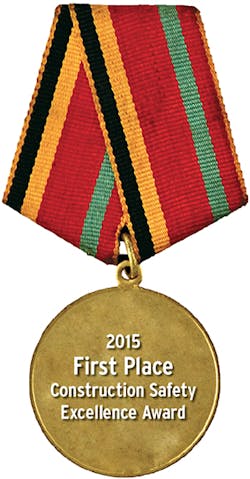If one US military officer could represent Gowan Construction, his chest would be covered on both sides with medals. Indeed, Gowan, a North Dakota heavy-highway contractor, has racked up a superior safety record over the past several years. The company recently won the 2015 First Place Construction Safety Excellence Award from the Associated General Contractors (AGC) of America—a national award—for Highway and Transportation Contractors, in the 100,000–300,000 hours worked category. That award follows many others since 2007:
AGC of North Dakota: Highway Division First Place Safety Award in 2009, 2010, and 2014.
AGC of North Dakota: Safety Excellence Award in 2007, 2008, 2009, 2010, 2011, 2012, 2013, and 2014.
Mine Safety and Health Administration (MSHA): Certificate of Achievement in Safety 2012 and 2014 for hours worked without a lost workday injury.
Gowan’s emphasis on safety comes straight from the top—from the Gowan family that owns the company. “Milt Gowan, our owner and president, is very good about going out onto our construction sites and talking to everybody about what’s going on at each site,” says Bob Sween, aggregate operations manager.
Safety is foremost on the minds of Gowan’s crews as well. Every day, crews start work with stretch and flex exercises designed to prevent muscle strains and the like. And every day, at toolbox meetings, a foreman or superintendent will review the Site Specific Safety Plan for the project. “We encourage our employees to participate in the safety topics, based on their day to day activities,” says Erika Martens, safety officer at Gowan.
Martens says employees might lead a daily presentation on wearing gloves, or near-misses, or on personal protective equipment. “They might talk about anything that could be done differently, like a flagger’s position,” says Martens. “If a flagger is having trouble being visible, or doesn’t feel they are in a safe spot, they will talk about that and adjustments will be made. We discuss weather conditions, and the dangers of slips and trips on icy or slippery surfaces.” Every crew member signs off on the daily toolbox meeting, and Gowan keeps records of the meetings.
Any Gowan employee can shut a job down at any time if something is unsafe. That’s a policy led by Milt Gowan, who stressed that fact in his speech at a recent companywide recognition luncheon. “If any employee doesn’t feel comfortable with what’s going on, that employee can shut the job down and discuss it and make sure we move forward safely,” says Sween. “It is our belief that nobody gets paid enough to get hurt or killed on the job. Any employee can shut a job down. That was emphasized by Mr. Gowan at the luncheon.”
Gowan rarely recognizes individual employees for safety practices; instead, the company includes everyone, or groups of employees, in cook-outs or a banquet that is held every January. “Often they’re not one large cook-out,” says Sween. “There will be a cook-out at one of our equipment shops in Grand Forks (ND) or a cook-out at our main office in Oslo (MN). And we’ll do a cook-out at our main gravel pit just to recognize the fact that we’re doing well and make sure we keep on doing well, and that everyone keeps safety as a top priority.
“Yesterday we had a companywide recognition luncheon for the national award that we won,” says Sween. “And last year Mr. Gowan and I went down to our Interstate highway project and cooked up 155 rib-eye steaks. We want to make sure that all our employees are recognized for what we did.”
Adds Martens: “By doing recognition that way, it holds everyone accountable. Everybody looks out for each other. If one of our employees sees another employee doing something they should not do, they stop it, walk over, explain what’s going on, and they don’t have issues with stopping work at any time.”
Site Specific Safety Plans include a Job Hazard Analysis that covers OSHA and MSHA standards if applicable. Job hazards can include, for example, overhead equipment or power lines, underground utilities, the equipment being operated, or any number of other things. Gowan owns and operates three open-pit aggregate mines, and they are subject to MSHA regulations.
“We train people at several different things,” says Martens. “All employees are trained every year at MSHA and OSHA, and every two years in CPR, first aid, and blood-borne pathogens. All employees are both site-specifically and safety trained before performing any work. And this includes all new hires. All new hires are taken through the whole process that all of our typical guys are taken through.”
She says most, if not all, employees receive OSHA 10-hour training, and foremen and superintendents get the OSHA 30-hour training course. “If they can’t get it right away then we sit them down and make sure they’re Site Specific Trained and then we get them scheduled for the 10-hour training,” says Martens.
Mine sites are inspected randomly at a minimum of once per year by MSHA. “It’s much more stringent than OSHA,” says Sween. “MSHA inspections can be very in-depth. They look at everything. MSHA inspections cover everything from electrical connections to guarding on equipment to haul roads and berms. They want to make sure berms are the right height. It’s very, very in-depth, and a lot depends on the inspector. They look at your paper work for personnel training; they’ll make sure that the employees sat down and did the task training.”
Disciplinary Action
“We have several categories of disciplinary action,” says Martens. “It all depends on the severity of the unsafe act, and whether it’s a repeat violation or not. Discipline ranges from one to three days off without pay to termination. Violations might be seat belts, late for work, rough-housing, goofing around, or just a blatant disregard for any safety measures. If you’re a third-time repeat, you don’t work here anymore.”




